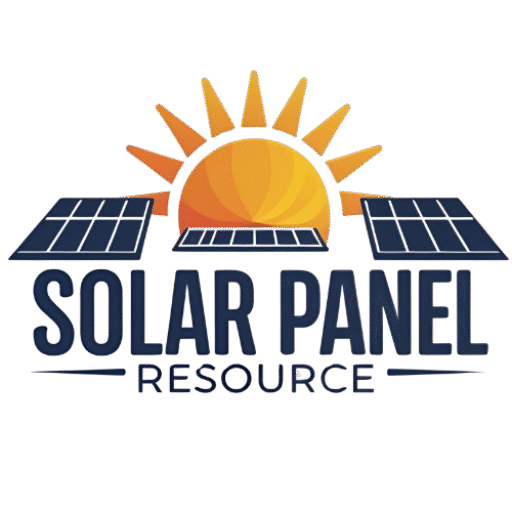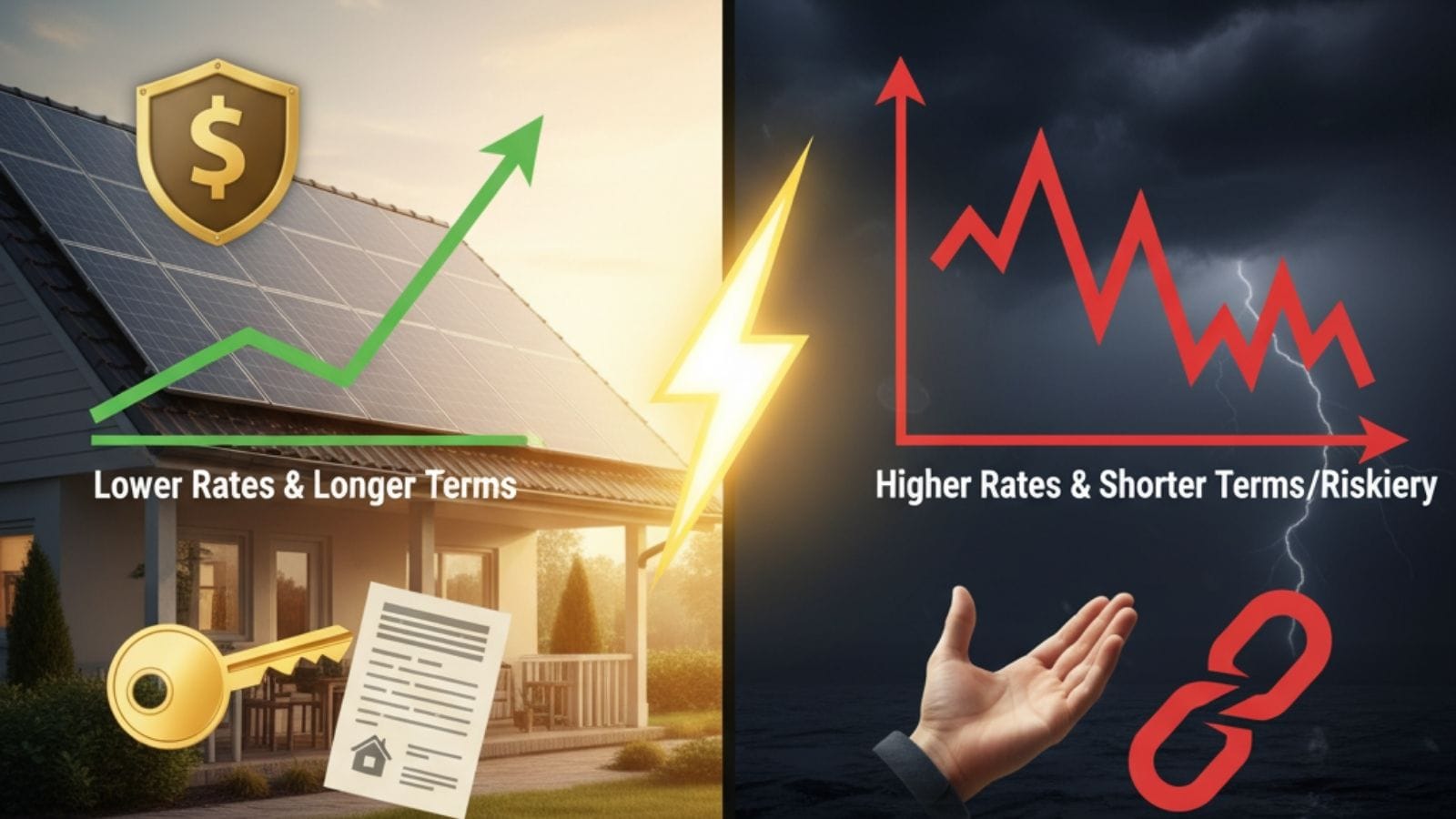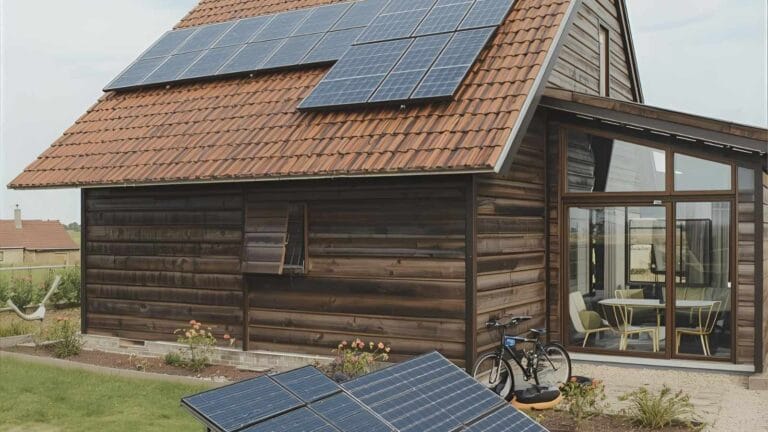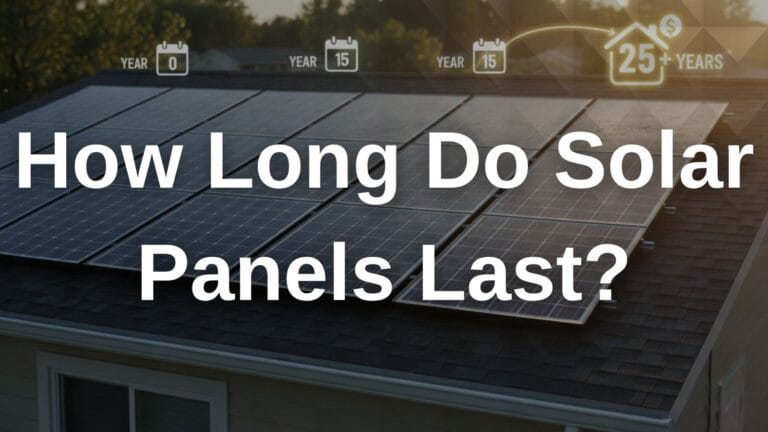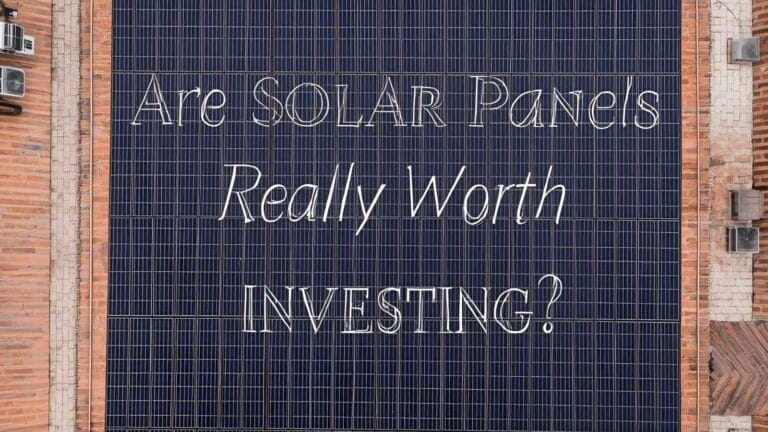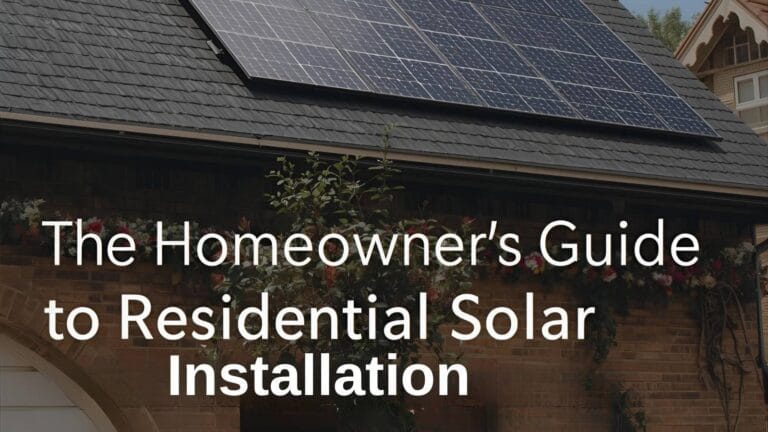HELOC vs. Unsecured Loan for Solar: Which Financing Option Is Best for You?
Choosing to install a solar energy system is a significant step toward financial and environmental independence. While a cash purchase offers the highest return on investment, it’s not a realistic option for most homeowners. This makes financing a crucial part of the decision-making process. Among the many types of solar loans available, two of the most popular and often-confused options are a Home Equity Line of Credit (HELOC) and an unsecured personal solar loan. Both allow you to finance a system without a significant upfront cost, but they differ fundamentally in their structure, risks, and benefits.
This in-depth guide will provide a side-by-side comparison of HELOCs and unsecured loans for solar installations in 2025. We’ll break down the pros and cons of each, explain how they work, and provide a clear framework to help you decide which option is the best fit for your financial situation. Our goal is to equip you with the expert knowledge needed to make a confident and financially sound choice.
Understanding the Core Difference: Secured vs. Unsecured
The primary distinction between a HELOC and an unsecured loan lies in whether the loan is secured by collateral. This single factor has a cascading effect on every other aspect of the loan, from interest rates to risk. A HELOC is a secured loan, while an unsecured solar loan is, as the name suggests, unsecured.
What is a HELOC? A Secured Loan
A Home Equity Line of Credit (HELOC) is a revolving line of credit that allows you to borrow money against the equity you have built up in your home. It’s similar to a credit card, but with a much lower interest rate because your home serves as the collateral. The lender places a lien on your property, which means that if you default on the loan, the lender can foreclose on your home to recover their money. You can draw funds from the line of credit as needed during a specific “draw period,” typically 10 years, and you only pay interest on the amount you borrow.
What is an Unsecured Solar Loan?
An unsecured solar loan, also known as a personal loan, is a financing option that does not require any collateral. You are borrowing based on your creditworthiness and income alone. The lender cannot place a lien on your home or your solar panels. If you fail to make payments, the lender’s only recourse is to report the default to credit bureaus and, in some cases, take legal action to collect the debt. This type of loan is often offered by specialized solar finance companies, credit unions, and traditional banks.
The Benefits and Drawbacks of a HELOC for Solar
Leveraging your home’s equity to finance a solar system is a strategy many homeowners consider. It can be an incredibly powerful tool, but it’s essential to understand both its advantages and its inherent risks.
HELOC Pros: The Power of Low-Cost Borrowing
- Lower Interest Rates: Because a HELOC is secured by your home, the lender takes on less risk. This allows them to offer significantly lower interest rates than unsecured loans. As of late 2025, national average HELOC rates are often in the 8-9% APR range, but can be much lower for borrowers with excellent credit.
- Flexibility: The “line of credit” structure gives you immense flexibility. You can borrow only what you need, when you need it. This is ideal if your project has a phased approach or if you anticipate additional costs like a battery installation later on.
- Tax Deductible Interest: The interest paid on a HELOC can be tax-deductible if the funds are used for a “substantial home improvement.” A solar installation falls squarely into this category, potentially providing an additional layer of savings.
- Higher Loan Amounts: A HELOC can often provide access to a larger pool of funds than an unsecured loan, making it a viable option for large, expensive solar systems or full home energy retrofits.
HELOC Cons: The Risk to Your Home
- Your Home is at Risk: This is the single biggest risk of a HELOC. If you default on the loan for any reason, the bank can foreclose on your home. This is a severe consequence that you must be comfortable with.
- Variable Interest Rates: Most HELOCs have variable interest rates that can rise or fall with the market (e.g., in line with the prime rate). This means your monthly payments could increase over time, making your long-term budgeting unpredictable. While some lenders offer fixed-rate options for a portion of the loan, the variable nature is a key consideration.
- Longer and More Complex Process: Getting a HELOC is a similar process to a mortgage refinance. It requires a home appraisal, a full credit check, and a thorough review of your financial history. The process can take several weeks to a few months to complete, which could be a problem if you’re trying to meet a deadline for a tax credit.
- Reduces Home Equity: While a solar system increases your home’s value, a HELOC immediately reduces your available equity. This could limit your ability to access funds for other large purchases or emergencies.
The Benefits and Drawbacks of an Unsecured Solar Loan

Unsecured solar loans have become a popular financing method due to their speed, simplicity, and lack of collateral requirements. They are a great alternative for those who don’t want to risk their home’s equity.
Unsecured Loan Pros: Speed and Safety
- No Collateral Required: This is the most significant advantage. Your home is not used as collateral, so there is no risk of foreclosure. This provides immense peace of mind.
- Faster Approval and Funding: The application process for an unsecured loan is generally much faster and less complex than a HELOC. The funds are often disbursed within a week, and sometimes even within a day, making it a great option if you need to act quickly.
- Fixed Interest Rates: Most unsecured solar loans come with a fixed interest rate. This means your monthly payments will be predictable and will never change for the entire term of the loan, making it easy to budget for the long term.
- No Prepayment Penalties: Many unsecured solar loans are designed to accommodate the 30% Federal Solar Tax Credit. They often include an 18-month “same-as-cash” period that allows you to pay down a large portion of the principal with your tax refund without incurring any prepayment penalties.
Unsecured Loan Cons: Higher Cost and Credit Dependency
- Higher Interest Rates: Without the security of your home as collateral, lenders take on more risk, which they mitigate by charging higher interest rates. Unsecured solar loans typically have rates in the 4-12% APR range, but they can be much higher depending on your credit score and the lender.
- Credit Score is Key: Your interest rate is heavily dependent on your credit score. To qualify for the lowest rates, you’ll need a score of 720 or higher. A lower score can result in a significantly higher APR, eroding your potential savings.
- Dealer Fees: It’s crucial to understand that many “low-interest” unsecured loans offered by solar installers come with high dealer fees, which can be as much as 20% of the loan amount. This fee is often rolled into the total loan amount and can make a seemingly attractive interest rate much more expensive in reality. Always ask for the cash price of the system and compare it to the financed price.
- Loan Amount Limitations: Unsecured loans typically have lower borrowing limits than HELOCs. While a HELOC might allow you to borrow up to 80% of your home’s equity, an unsecured loan for solar is usually capped at a maximum of $100,000.
A Side-by-Side Comparison for 2025
To put everything into perspective, here is a detailed comparison table to help you evaluate your options. Remember, the best choice depends on your personal financial situation and risk tolerance.
| Feature | HELOC | Unsecured Solar Loan |
|---|---|---|
| Collateral | Your home (Secured). | None (Unsecured). |
| Interest Rate | Lower, but typically variable. | Higher, but almost always fixed. |
| Risk | Risk of foreclosure if you default. | No risk of foreclosure. |
| Speed to Funding | Slower (weeks to months). | Faster (days to a week). |
| Flexibility | High. Can draw funds as needed. | Low. Lump sum is disbursed at once. |
| Tax Benefits | Interest may be tax-deductible. | No tax deduction on interest. |
| Eligibility | Requires home equity and good credit. | Requires good to excellent credit. |
Which Solar Loan is Right for You?
There is no universally “best” option. The right choice depends on your personal financial situation, your risk tolerance, and your priorities. Here is a simple decision-making framework to guide you:
Choose a HELOC If:
- You have a significant amount of equity in your home.
- You are confident in your ability to make payments and are comfortable with the risk of using your home as collateral.
- You want the lowest possible interest rate and the potential for a tax deduction on the interest.
- You are not in a rush to get the project done and can wait for the longer approval process.
Choose an Unsecured Solar Loan If:
- You are not comfortable with the idea of using your home as collateral.
- You want a fast, simple, and straightforward application process.
- You want a fixed interest rate and predictable monthly payments for the life of the loan.
- You have a strong credit score (720+) and can qualify for a competitive rate.
A crucial factor to consider for any financing option is the federal solar tax credit. As the system owner, you are eligible to claim this credit, which allows you to deduct 30% of your total system cost from your federal tax bill. Both HELOCs and unsecured loans allow you to qualify for this credit, as they are both forms of system ownership. This is a significant advantage over solar leases or PPAs, where the third-party company claims the credit.
Financing a solar system can feel daunting, but by carefully weighing these two popular options, you can choose the one that not only fits your budget but also provides peace of mind. Both loans put you on the path to ownership, allowing you to maximize your long-term savings and truly take control of your energy future.
For more information on different types of green home improvement loans and their benefits, you can refer to resources from reputable financial institutions and government agencies. The U.S. Department of Energy and Bankrate provide excellent guides on this subject. These resources can help you understand the nuances of these loans and how they can be used to finance energy-efficient upgrades.
Frequently Asked Questions (FAQ)
What is the difference between a HELOC and a Home Equity Loan?
A Home Equity Loan is a lump-sum, fixed-rate loan that you receive all at once. A HELOC is a revolving line of credit that you can draw from as needed, with a variable interest rate.
Do I need a high credit score to get a solar loan?
While some lenders may offer loans to individuals with fair credit, a credit score of 720 or higher is generally required to secure the lowest interest rates on both HELOCs and unsecured loans. A high score can save you thousands of dollars over the life of the loan.
Can I finance a solar battery with a loan?
Yes. Both HELOCs and unsecured loans can be used to finance a solar battery. The battery is a qualified solar energy property, meaning its cost is eligible for the 30% federal tax credit, even if it is installed at a different time from the main solar system.
What happens if I sell my home with a solar loan?
Since the loan is tied to you personally, not the property, you are responsible for paying it off. You can either use the proceeds from the home sale to pay off the balance or transfer the loan to your new property, depending on the terms of your agreement with the lender.

Solar Energy Enthusiast & Renewable Energy Researcher
Vural’s journey into solar energy began four years ago, driven by frequent power outages and high electricity bills at his own home. He has since gained hands-on experience with both personal and commercial solar projects. At solarpanelresource.com, Vural shares his real-world insights and in-depth research to guide homeowners and business owners on their own path to energy independence.
